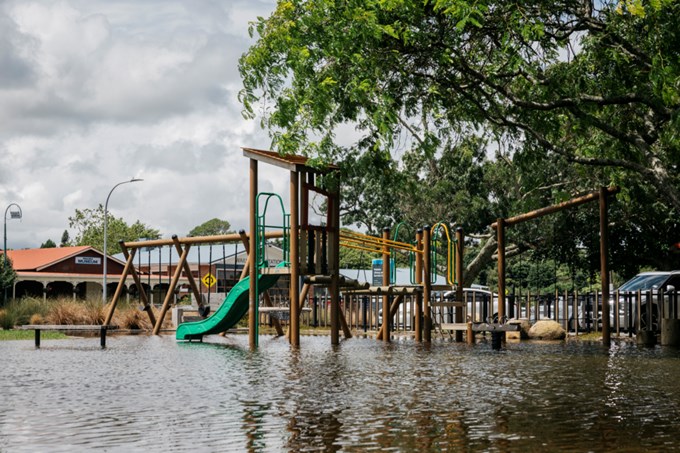Public parks, facilities and open spaces across Tāmaki Makaurau took a battering during the severe weather events of January and February, but council teams have been working hard to make repairs, clean-up damage, restore assets in a more resilient way and reopen the parks, playgrounds and tracks that Aucklanders love.
“Across the council network, the damage caused by the floods and storms this year has been unprecedented.
“Effects have been varied, from minor damage and flooding to some cases where we have had major slips damaging community assets, blocking access, or other extensive forms of damage that may require considerable cost to repair or completely replace,” says Councillor Richard Hills, Chair of the Planning, Environment and Parks committee.
“In these cases, we take the approach of building with resilience. This means working with mana whenua, local boards and the community to understand the options and make our assets more resilient – even if that means having tough conversations to eventually remove or retire assets if we cannot safely replace them.”
Councillor Angela Dalton, Deputy Chair of the Planning, Environment and Parks committee says the committee knows the community misses many of these assets, especially our tracks.
“In the last few months, council staff have focussed on progressing the clean-up of storm waste, making areas that create public risk safe again and get minor repairs completed as quickly as possible,” says Cr Angela Dalton.
“We appreciate the patience of the community as the council kaimahi work to get this work completed and get Aucklanders back into our parks, and enjoying our tracks and playgrounds once again.”
Storm impact across the Auckland region
This year, we have recorded 1,012 cases of storm damage to our assets and facilities across the Auckland region (flooding, damage to assets and washouts of tracks and pathways) and recorded approximately 332 slips on council land. This has resulted in around 1,330 assets that have sustained damage.
Investigations for damage that is more extensive are underway for many of the cases, although the widespread damage means this will take some months to complete. The estimated damage is likely to cost between $40 and $55 million.
“We are extremely lucky to have such dedicated and passionate kaimahi across our local area operations teams, regional parks and operations and our volunteer teams, who responded well to immediate risks during and soon after the storm events and continue to progress the work,” says Taryn Crewe, General Manager, Parks and Community Facilities.
Many of our assets were impacted but recovery is underway. Around 520 jobs have been completed, this is mainly clean-ups and access restoration, as well as minor repairs and flooding damage.
This is close to 50 per cent of the 1,330 of the reported damaged assets, including:
- 63 playgrounds with 46 now fixed
- 309 tracks with 122 re-opened
- 216 buildings with 89 repairs completed.
Tracks update
Geotechnical expertise across Tāmaki Makaurau and further afield has been focused on critical slip assessments, therefore work that can wait a little longer will happen in due course. Once geotechnical reports are done, our teams determine what action, if any, is needed.
Of the estimated 332 slips on council land, we have received reports back from geotechnical engineers on around 27 per cent of those slips, and around 50 per cent of the critical slips have been assessed.
Storm impacts across our regional parks are extensive – 39 tracks that were open before the storm events remain closed. The west was particularly affected with 75 per cent of the open track network in the western regional parks impacted.
A large majority of our tracks have reopened, with a smaller amount across the region still closed as we assess the damage and determine the best course of action.
Trees update
Due to slips, wind and extremely wet conditions, many trees were heavily impacted including losing perfectly healthy trees across the network under conditions that would normally withstand heavy rain.
We recorded over 7,000 tree requests and to date around 2,800 trees have had to be removed due to them having fallen or presenting a risk to life or property.
At the peak of the storms, our contractors had around 37 crews out, allowing us to quickly progress recovery. We have completed around 92 per cent of the jobs with the remaining and less critical works scheduled for this month.
Building back with resilience
The recovery process will take time. We continue to work through recovery and the more significant damage across the region, particularly some of the larger slips.
“We have some great success stories across the network that shows how well many of our assets stood up to the severe weather and emphasise the importance of building with resilience in mind,” says Taryn.
Kinloch Reserve at Orewa Beach had significant stream, reserve and coastal damage including a bridge that failed. As an interim solution, the pathway has been directed down onto the beach as we continue our planning for the northern seawall to create a more resilient solution to protect the reserve and access ways.
Many of our leisure and pool facilities were also significantly impacted. As part of the renewal, the design of West Wave Pool and Cameron Pool are being looked at to mitigate this happening again, where possible.
Franklin Pool and Leisure and Otara and Manurewa aquatic centres are great success stories of where improved resilience has worked.
“Both facilities were impacted by floods and stormwater flooding in the past, and in this recent round of weather events, they did not flood. This was in part due to the works to build back more resilience,” says Taryn.


